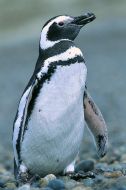Magellanic Penguin
Pingüino Patagónico
Spheniscus magellanicus
Total length: 700mm. Sexes alike; dark grey bill; iris greyish brown; head, neck and back dark grey; from either side of base of bill a broad white band extends over the orbital area and then loops over the auricular region, joining on throat; breast and belly white; dark grey band extending from upper part of breast or base of neck down flanks to lower part of thighs; upperside of flippers as back and underside white with blackish grey spots; some specimens have a white spot on upper tail coverts. Feet black- speckled grey.
During the breeding season male and female adults lose the feathers in the forehead and around eyes, and the eye- ring turns pink. Chicks are born with dark greyish brown down on back and whitish underparts; juveniles’ back is paler grey than adults and lack the typical double-collared neck. Due to its breeding sites on continental beaches, the Magellanic Penguin is the commonest and best known species. Habitat and behaviour: in September Magellanic Penguins start gathering in large colonies on sandy shores where they build their nests digging a burrow in the sand. Females lay two white eggs. Incubation, feeding and guard duties are shared equally between both parents. Once eggs hatch, parents take turns, one day foraging, one day guarding the nest. The comings and goings to and from the sea, territorial disputes, ritual courtship and constant calls that resemble braying, turn these bustling colonies into an attractive and unique sight. Often, it is possible to see most individuals leave the burrows at dusk and greet the end of the day with a noisy choir. Nesting grounds are on the Patagonian coastline of the province of Chubut, from Península Valdés to Cabo Vírgenes in south Santa Cruz; many colonies are found on offshore islands and at Islas Malvinas.
As from late February and upon moulting they return to the sea, and by April colonies are deserted; penguins are pelagic and forage in the open ocean the rest of the year until the following breeding season.
Range: south of Isla de los Estados up to north of Chubut, foraging even off shore south of Brazil.
Illustrated Handbook of the Birds of Patagonia
Kindness: Kovacs Family |









